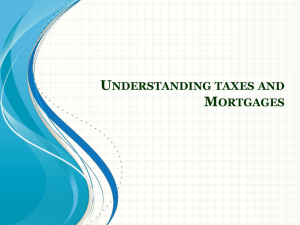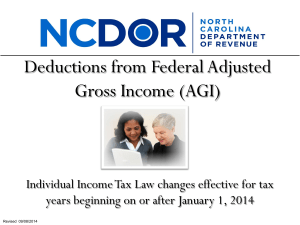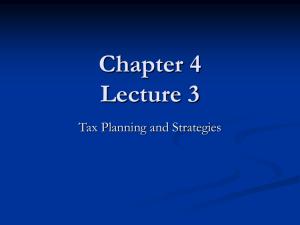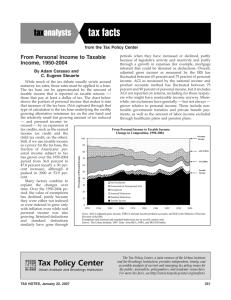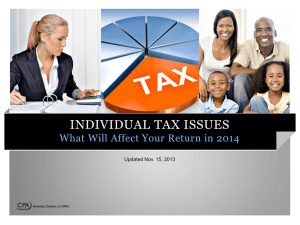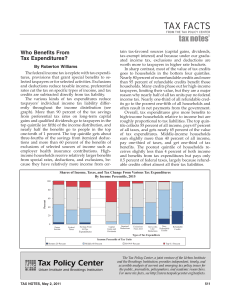Options to Limit the Benefit of Tax Expenditures for High-Income... Daniel Baneman, Jim Nunns, Jeffrey Rohaly, Eric Toder, Roberton Williams
advertisement
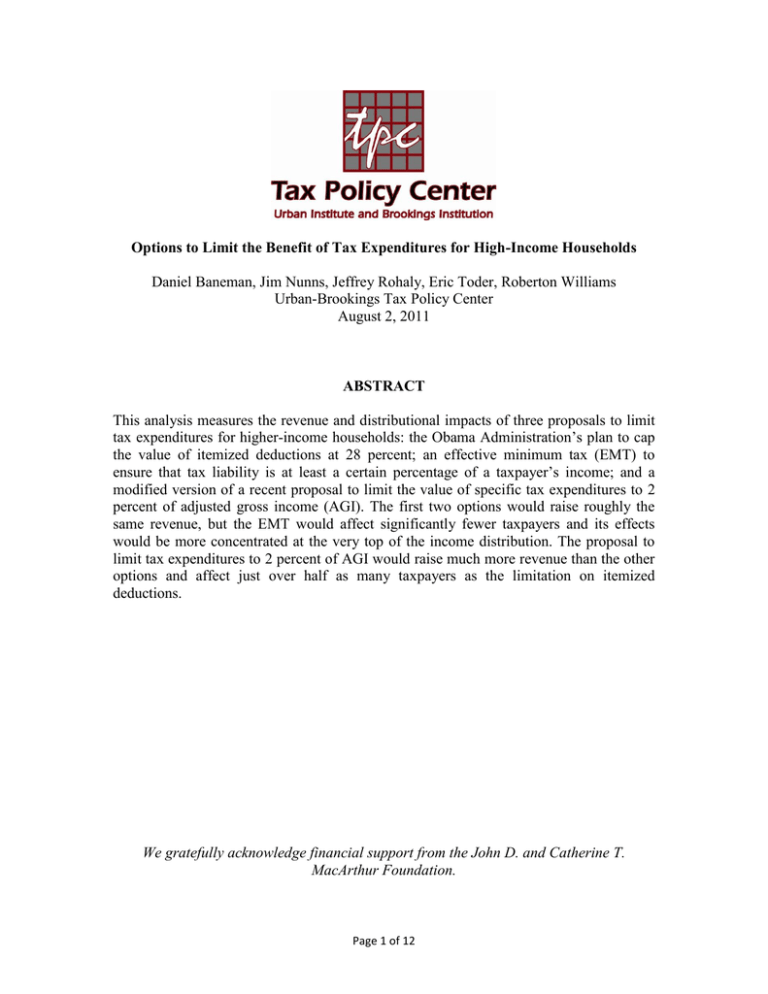
Options to Limit the Benefit of Tax Expenditures for High-Income Households
Daniel Baneman, Jim Nunns, Jeffrey Rohaly, Eric Toder, Roberton Williams
Urban-Brookings Tax Policy Center
August 2, 2011
ABSTRACT
This analysis measures the revenue and distributional impacts of three proposals to limit
tax expenditures for higher-income households: the Obama Administration’s plan to cap
the value of itemized deductions at 28 percent; an effective minimum tax (EMT) to
ensure that tax liability is at least a certain percentage of a taxpayer’s income; and a
modified version of a recent proposal to limit the value of specific tax expenditures to 2
percent of adjusted gross income (AGI). The first two options would raise roughly the
same revenue, but the EMT would affect significantly fewer taxpayers and its effects
would be more concentrated at the very top of the income distribution. The proposal to
limit tax expenditures to 2 percent of AGI would raise much more revenue than the other
options and affect just over half as many taxpayers as the limitation on itemized
deductions.
We gratefully acknowledge financial support from the John D. and Catherine T.
MacArthur Foundation.
Page 1 of 12
This analysis considers three proposals that would limit tax expenditures for higherincome households: the Obama Administration’s proposal to cap the value of itemized
deductions at 28 percent; a minimum tax to ensure that tax liability is at least a certain
percentage of a taxpayer’s income; and a modified version of the
Feldstein/Feenberg/MacGuineas (FFM) proposal to limit the value of specific tax
expenditures to 2 percent of adjusted gross income (AGI).
To measure the revenue and distributional implications of these proposals, the analysis
considers two baselines: current law and current policy. “Current law” is the standard
baseline that official revenue estimators at the Joint Committee on Taxation use to score
tax proposals. It assumes that tax law plays out as it is currently written. Most important,
that means that the 2001–2010 income and estate tax cuts expire at the end of 2012 and
that temporary relief from the alternative minimum tax (AMT) expires at the end of 2011.
The “current policy” baseline assumes that Congress permanently extends all provisions
in the 2011 tax code (except the 2 percent reduction in Social Security payroll tax) as
well as AMT relief, indexed for inflation after 2011.
Option 1: 28 Percent Limitation on Itemized Deductions
The tax savings from itemized deductions depend on a taxpayer’s marginal tax rate. For
someone in the 35 percent top tax bracket, an additional $100 of itemized deductions
reduces tax liability by 35 percent of that $100, or $35.1 The first option is a proposal
from the Obama Administration, which would limit the benefit of itemized deductions to
28 percent. This would effectively reduce the benefit of itemized deductions for
taxpayers with a marginal tax rate above the 28 percent limit. 2 Thus, for example, an
additional $100 of itemized deductions would save a taxpayer in the 35 percent bracket
only $28 rather than $35.3
The 28 percent limitation on itemized deductions would raise an estimated $288 billion
over the next ten years compared with current law (see Table 1). 4 Relative to current
policy, the proposal would raise $164 billion. The smaller revenue gain versus current
policy results in part from the lower top tax rates—33 and 35 percent versus 36 and 39.6
percent under current law. The smaller difference between the statutory rates and the 28
percent limitation would result in smaller tax increases and hence less additional revenue.
1
This simplified example ignores the impact of phase-ins and phaseouts in the tax code that can cause a
taxpayer’s effective marginal tax rate to differ from her statutory rate.
2
For a married couple claiming the standard deduction and personal exemptions only, and expressed in
2009 dollars, the 28 percent bracket would end at AGI of $227,500 under current policy in 2013, and at
$153,800 under current law ($180,850 and $91,500 for singles, $205,800 and $133,050 for heads of
household).
3
Appendix A provides technical details of the modeling assumptions for all three options examined.
4
Appendix Table A1 provides year-by-year revenue estimates against both current law and current policy.
Revenue estimates include a microdynamic behavioral response but do not include any potential short-term
timing shifts due to tax rate changes on realized capital gains.
Page 2 of 12
Table 1
Impact on Individual Income Tax Revenue (billions of current dollars)
2012-21 Fiscal Years
Current Law
Option 1: Limit Value of Itemized Deductions to 28 Percent
Option 2: Effective Minimum Tax a
Option 3: Limit Tax Expenditures to 2 Percent of AGI
287.9
258.4
592.3
Current Policy
164.2
169.0
519.7
Source: Urban-Brookings Tax Policy Center Microsimulation Model (version 0411-2).
Notes: Proposals are effective 01/01/12. Estimates include a microdynamic behavioral response.
a. The effective minimum tax rate would be 27 percent under current law and 21 percent under
current policy.
In 2013 against current policy, the proposal would increase taxes for about 5.4 million tax
units, or 3.3 percent of all tax units, by an average of about $2,850 (see Table 2).5 The
proposal would affect no households in the bottom two income quintiles and just 0.2
percent of those in the third and fourth quintiles. The 5.3 million affected households in
the top quintile would see their taxes go up by an average of about $2,900.6 The average
tax increase for the 697,000 affected households in the top 1 percent would be about
$13,300.7
Almost all of the tax increase—99.8 percent—would fall on households in the top
quintile of the income distribution—those with cash incomes greater than $111,000 (see
Table 3). The top 1 percent would bear 61 percent and the top 0.1 percent would pay a
little more than one-third. The higher tax would reduce after-tax income of households in
the top quintile by 0.3 percent and that of households in the top 1 percent by 0.6 percent.
5
Appendix Tables A2 and A3 provide estimates against 2013 current law. The TPC website contains
complete distribution tables at http://www.taxpolicycenter.org/numbers/displayatab.cfm?SimID=403.
6
We use the terms “tax units” and “households” interchangeably although the two concepts differ. See
http://www.taxpolicycenter.org/numbers/displayatab.cfm?DocID=1535#q6.
7
The cash income percentile classes in the tables contain an equal number of people, not tax units. The
percentile breaks in 2011 dollars are 20% $17,910; 40% $37,091; 60% $64,533; 80% $111,349; 90%
$160,384; 95% $227,324; 99% $593,011; 99.9% $2,682,257.
Page 3 of 12
Table 2
Tax Units With a Tax Increase Under Current Policy, 2013 Calendar Year
Cash Income
Percentile
Lowest Quintile
Second Quintile
Middle Quintile
Fourth Quintile
Top Quintile
All
All Tax
Units
('000s)
28 Percent Limit on
Itemized
Deductions
Avg Tax
Number
Increase
('000s)
($)
21 Percent Effective
Minimum Tax
Number
('000s)
Avg Tax
Increase
($)
Limit Tax
Expenditures to 2
Percent of AGI
Avg Tax
Number
Increase
('000s)
($)
43,362
37,681
32,699
27,208
24,067
166,272
0
0
26
93
5,268
5,387
0
0
156
301
2,917
2,857
0
0
0
0
394
394
0
0
0
0
80,473
80,472
0
0
0
0
2,851
2,851
0
0
0
0
16,521
16,521
12,130
5,919
4,805
1,213
124
283
985
3,207
697
96
447
678
1,570
13,283
53,632
0
0
113
243
38
0
0
19,313
109,056
401,513
13
42
1,883
828
84
396
1,262
3,762
46,575
240,673
Addendum
80-90
90-95
95-99
Top 1 Percent
Top 0.1 Percent
Source : Urban-Brookings Tax Policy Center Microsimulation Model (version 0411-2).
Notes: Includes both filing and non-filing units but excludes those that are dependents of other tax
units. Tax units with negative cash income are excluded from the lowest quintile but are included in
the totals.
Option 2: Effective Minimum Tax (EMT)
The second option would ensure that high-income taxpayers pay at least a certain
percentage of their income in tax. The specific option examined here would require that
taxpayers with income above specified thresholds pay tax of at least 27 percent of their
modified adjusted gross income (MAGI), defined as AGI plus interest from currently taxexempt municipal bonds. 8 Taxpayers would calculate their tax under current rules,
compare that to their tentative effective minimum tax of 27 percent of their MAGI, and
pay the higher of the two amounts.9
8
The 27 percent rate would apply under current law. The minimum tax rate would be 21 percent when
assessed against current policy. These rates would raise approximately the same revenue as the 28 percent
limitation on itemized deductions.
9
In order to avoid double taxation of income earned abroad, the proposal would allow taxpayers to subtract
the foreign tax credit from their tentative effective minimum tax. In addition, as with the other two options,
this proposal would retain the current alternative minimum tax. Thus, taxpayers would first compare their
regular tax to their tentative AMT in order to determine their tax liability under current rules. They would
then compare that amount to their tentative EMT and pay the higher amount. The AMT could be repealed
simultaneously with the imposition of the effective minimum tax, but that would require a higher minimum
tax rate or a lower income threshold in order to raise the same amount of revenue.
Page 4 of 12
Table 3
Distributional Impact Under Current Policy, 2013 Calendar Year
Cash Income
Percentile
Lowest Quintile
Second Quintile
Middle Quintile
Fourth Quintile
Top Quintile
All
All Tax
Units
('000s)
28 Percent Limit on
Itemized
Deductions
Percent
Share of
Change in
Total Tax
After-Tax
Change
Income
21 Percent Effective
Minimum Tax
Percent
Share of
Change in
Total Tax
After-Tax
Change
Income
Limit Tax
Expenditures to 2
Percent of AGI
Percent
Share of
Change in
Total Tax
After-Tax
Change
Income
43,362
37,681
32,699
27,208
24,067
166,272
0.0
0.0
0.0
0.2
99.8
100.0
0.0
0.0
0.0
0.0
-0.3
-0.2
0.0
0.0
0.0
0.0
100.0
100.0
0.0
0.0
0.0
0.0
-0.6
-0.3
0.0
0.0
0.0
0.0
100.0
100.0
0.0
0.0
0.0
0.0
-0.9
-0.5
12,130
5,919
4,805
1,213
124
0.8
4.4
33.3
61.2
34.3
0.0
-0.1
-0.4
-0.6
-0.8
0.0
0.0
7.6
92.4
53.0
0.0
0.0
-0.2
-1.8
-2.4
0.0
0.1
15.5
84.4
44.5
0.0
0.0
-0.6
-2.6
-3.2
Addendum
80-90
90-95
95-99
Top 1 Percent
Top 0.1 Percent
Source: Urban-Brookings Tax Policy Center Microsimulation Model (version 0411-2).
Notes: Includes both filing and non-filing units but excludes those that are dependents of other tax
units. Tax units with negative cash income are excluded from the lowest quintile but are included in
the totals.
In order to limit the effective minimum tax to higher-income taxpayers, the rate would
phase in proportionately between MAGI of $250,000 and $500,000 for married couples
filing a joint return and between $200,000 and $400,000 for singles and heads of
household.10 Thus, for example, a married couple with MAGI of $300,000 would face a
minimum tax equal to 5 percent of their MAGI—one-fifth of the full 25 percent rate
because their $300,000 MAGI is one-fifth of the way into the $250,000–$500,000 phasein range. The minimum tax would not apply to households with MAGI below the
$250,000/$200,000 thresholds.
Compared against current law, the EMT rate of 27 percent would generate $258 billion of
additional revenue over the 2012–2021 period, roughly the same as the first option (see
Table 1). Against current policy, a lower rate of 21 percent would generate about the
same revenue as the 28 percent limitation, or $169 billion.
10
The phase-in range would be $125,000 to $250,000 for married individuals filing a separate return. All
thresholds in this paper would be indexed for inflation after 2009.
Page 5 of 12
Although it would raise roughly the same revenue as the 28 percent limitation on
itemized deductions, the EMT would affect significantly fewer taxpayers, would raise the
tax burden on those affected by much more, and would be more concentrated on those at
the very top of the income distribution. In 2013 against current policy, the proposal
would increase taxes for just 394,000 tax units, about 0.2 percent of all tax units (see
Table 2). The 2 percent of households in the top quintile affected by the tax would see
their taxes go up by an average of $80,500. The 243,000 affected households in the top 1
percent would incur an average tax rise of $109,000. The tax increase would average
$401,500 for the 38,000 affected households in the top 0.1 percent—those with cash
income of at least $2.7 million.
About 92 percent of the overall tax increase would fall on the top 1 percent and half on
the top 0.1 percent (see Table 3). After-tax income would fall an average of 0.6 percent
for households in the top quintile, by 1.8 percent for those in the top 1 percent, and by 2.4
percent for those in the top 0.1 percent.
Option 3: Limit Benefit of Tax Expenditures to 2 Percent of AGI
In a recent National Bureau of Economic Research paper, Martin Feldstein, Daniel
Feenberg, and Maya MacGuineas evaluated a proposal to cap the tax savings from
specified tax expenditures at 2 percent of a taxpayer’s AGI.11 We examine a modified
version of this proposal that would apply the cap only for high-income households.
The modified FFM proposal examined here would limit the value of itemized deductions,
the exclusion for employer-sponsored health insurance (ESI) premiums, and the child and
dependent care and general business tax credits to 2 percent of a taxpayer’s adjusted
gross income.12 The cap would phase in for married couples with AGI between $250,000
and $500,000 and for singles and heads of household with AGI between $200,000 and
$400,000.13
A 2 percent limitation on tax expenditures would raise $592 billion relative to current law
over the 2012–21 budget window, significantly more revenue than either of the other two
options (see Table 1). The plan would raise less revenue against current policy—$520
billion—because of that baseline’s lower marginal rates, which reduce the value of
itemized deductions and exclusions.
Although this proposal would raise much more revenue, it would affect only about half as
many households as the 28 percent limitation on itemized deductions. The $16,500
average tax increase in 2013 for the 2.9 million affected households would be nearly six
times that for the 28 percent limitation (see Table 2). The 828,000 affected households in
the top 1 percent of the income distribution would pay an average of $46,600 more in
11
See “Capping Individual Tax Expenditure Benefits” at http://www.nber.org/papers/w16921.pdf.
Feldstein summarized the proposal in a New York Times opinion piece, available at
http://www.nytimes.com/2011/05/05/opinion/05feldstein.html?_r=2&hp.
12
In addition to ESI premiums paid by the employer, the limitation would also apply to premiums paid by
the employee with pre-tax dollars and contributions to a medical flexible savings arrangement (FSA) or a
health savings account (HSA).
13
The phase-in range for married individuals filing separate returns would be $125,000 to $250,000.
Page 6 of 12
taxes. Within the top 0.1 percent, about 84,000 households would see their taxes rise by
an average of about $240,000. Compared with the limitation on itemized deductions, that
represents about 12 percent fewer affected households in that top income range, but an
average tax increase that is more than four times as much.
The distribution of the increased tax burden across income groups closely resembles that
of the effective minimum tax and is therefore more concentrated toward the top of the
distribution than is the limitation on itemized deductions. Approximately 84 percent is
borne by the top 1 percent and 45 percent by the top 0.1 percent (see Table 3). The tax
increase would reduce after-tax income by 0.9 percent for households in the top quintile,
by 2.6 percent for those in the top 1 percent, and by 3.2 percent for those in the top 0.1
percent.
Page 7 of 12
Appendix A: Technical Modeling Assumptions
Option 1: 28 Percent Limitation on Itemized Deductions
The Obama Administration has proposed the 28 percent limitation on itemized
deductions in each of its budgets but has not provided specific details for how the plan
would be implemented. This analysis assumes taxpayers would first calculate their tax
liability under the regular tax law—that is, ignoring the alternative minimum tax (AMT).
They would then recompute tax liability on a tax base equal to taxable income plus
itemized deductions and subtract an “itemized deduction credit” equal to 28 percent of
their itemized deductions. Tax liability under regular tax rules would equal the larger of
the two calculated tax amounts.
Taxpayers would then calculate their tentative AMT in two ways, first under the rules in
place in the baseline and then on a tax base equal to AMT taxable income plus all
itemized deductions allowed for AMT purposes and subtracting 28 percent of itemized
deductions allowed for AMT purposes. The larger of the two amounts would then be
tentative AMT.
Finally, taxpayers would compare tentative AMT to regular tax liability and pay the
larger amount. The difference, if positive, would be the taxpayer’s AMT liability.
Under current law, the limitation on itemized deductions or “Pease” would still be in
place. Thus, “itemized deductions” in the current law calculations for the regular tax refer
to itemized deductions after the Pease limitation has been applied.14 In contrast, Pease
does not apply under the current policy baseline.
Option 2: The Effective Minimum Tax
For taxpayers with modified AGI above specified thresholds—$250,000 for married
couples filing a joint return and $200,000 for others—the EMT would equal the
applicable minimum tax rate times modified AGI, minus foreign tax credits, where
modified AGI is AGI plus tax-exempt interest income. Taxpayers would then pay the
larger of tax liability calculated under the tax law in place in the baseline and the
minimum tax amount. Taxpayers with modified AGI of $500,000 for married couples
filing a joint return ($400,000 for singles and heads of household) would pay the full
minimum tax rate.
To avoid a “cliff” at which an additional dollar of income could impose a very large
increase in tax liability, the minimum tax would phase in proportionately for married
couples with modified AGI between $250,000 and $500,000 and for singles and heads of
household with modified AGI between $200,000 and $400,000.15
For example, consider a married couple with modified AGI of $350,000. Their income
would put them $100,000 into the $250,000 wide phase-in range, so their minimum tax
14
Pease does not apply for AMT purposes.
The phase-in range for married individuals filing separate returns would be $125,000 to $250,000. All
amounts would be indexed for inflation after 2009.
15
Page 8 of 12
rate would be $100,000/$250,000, or 40 percent of the fully phased-in rate. If the fully
phased-in rate were 27 percent, they would face a minimum tax rate of 10.8 percent and
their minimum tax would equal 10.8 percent of their modified AGI of $350,000, or
$37,800. The couple would then pay the larger of $37,800 or their tax liability calculated
under regular tax rules, including any applicable AMT liability.
Option 3: Limit Value of Tax Expenditures to 2 Percent of AGI
Taxpayers with adjusted gross incomes greater than specified thresholds—$250,000 for
married couples and $200,000 for others—would calculate their tax liability two ways.
They would first calculate their individual income tax under regular rules, including any
applicable AMT liability. They would then recalculate their tax liability assuming no
itemized deductions and no child and dependent care and general business tax credits and
counting as income any health insurance premiums paid by themselves using pre-tax
dollars or by their employers. 16 They would subtract 2 percent of their AGI from the
latter amount to get their “expenditure-limited” tax and pay the larger of that amount and
their regular tax.
For example, consider a taxpayer with AGI of $3,000,000 whose tax liability would equal
$600,000 under regular income tax rules and for whom disallowing the specified tax
expenditures would result in tax liability of $800,000. The taxpayer’s benefit from the
specified tax expenditures equals the difference—$200,000. Because that benefit exceeds
2 percent of AGI, or $60,000, the limitation would apply, boosting final tax liability to
$740,000—the difference between the $800,000 tax and the $60,000 limit on the value of
tax expenditures.
To avoid creating a cliff at the threshold values of $250,000/$200,000, the limitation
would phase in proportionately over the AGI range of $250,000 to $500,000 for married
couples filing a joint return and $200,000 to $400,000 for singles and heads of
household.17 Consider, for example, a married couple with AGI of $300,000 who would
owe $40,000 under regular income tax rules and for whom disallowing tax expenditures
would raise their tax to $70,000. If the proposal were fully phased in, they would pay
$64,000, which is the larger of $40,000 and $70,000 less 2 percent of AGI. That amount
would represent $24,000 more than they would pay under regular tax rules. Since the
couple is $50,000 into the $250,000 wide phase-in range, the additional amount they
would owe would be limited to 50/250 or 20 percent of that extra amount—$4,800—
yielding a final tax liability of $40,000 + $4,800 = $44,800.
16
Taxpayers would also have to include in income any contributions to medical FSAs or HSAs.
The phase-in range for married individuals filing separate returns would be $125,000 to $250,000. All
amounts would be indexed for inflation after 2009.
17
Page 9 of 12
Appendix Table A1
Impact on Individual Income Tax Revenue (billions of current dollars), 2012-21
Fiscal Year
2012
2013
2014
2015
2016
2017
2018
2019
2020
2021
2012-21
Baseline: Current Law
Option 1: Limit Value of Itemized Deductions to 28 Percent
Option 2: 27-Percent Effective Minimum Tax
Option 3: Limit Tax Expenditures to 2 Percent of AGI
8.8
20.6
25.6
20.9
14.2
46.9
25.3
19.8
52.8
27.2
24.6
55.9
29.2
26.4
59.5
31.1
27.7
63.1
33.0
29.1
66.6
35.0
30.7
70.1
37.3
32.3
73.9
40.1
33.0
78.0
287.9
258.4
592.3
Baseline: Current Policy
Option 1: Limit Value of Itemized Deductions to 28 Percent
Option 2: 21-Percent Effective Minimum Tax
Option 3: Limit Tax Expenditures to 2 Percent of AGI
7.4
9.5
27.0
12.2
10.1
41.0
13.7
5.3
44.5
14.8
14.7
47.6
16.0
19.1
50.7
17.3
20.1
54.3
18.7
21.1
58.0
20.0
22.2
61.6
21.3
23.3
65.4
22.8
23.6
69.6
164.2
169.0
519.7
Source: Urban-Brookings Tax Policy Center Microsimulation Model (version 0411-2).
Notes: Proposals are effective 01/01/12. Estimates include a microdynamic behavioral response.
Page 10 of 12
Appendix Table A2
Tax Units With a Tax Increase Under Current Law, 2013 Calendar Year
Cash Income
Percentile
Lowest Quintile
Second Quintile
Middle Quintile
Fourth Quintile
Top Quintile
All
All Tax
Units
('000s)
28 Percent Limit on
Itemized
Deductions
Avg Tax
Number
Increase
('000s)
($)
27 Percent Effective
Minimum Tax
Number
('000s)
Avg Tax
Increase
($)
Limit Tax
Expenditures to 2
Percent of AGI
Avg Tax
Number
Increase
('000s)
($)
43,362
37,681
32,699
27,208
24,067
166,272
0
0
0
784
10,400
11,183
0
0
0
203
2,788
2,605
0
0
0
0
489
489
0
0
0
0
68,046
68,046
0
0
0
0
2,932
2,932
0
0
0
0
18,864
18,864
12,130
5,919
4,805
1,213
124
1,579
3,919
3,874
924
103
529
660
2,173
18,252
75,640
0
0
129
324
36
0
0
17,784
88,096
419,250
13
44
1,993
807
74
435
1,477
5,490
53,167
277,578
Addendum
80-90
90-95
95-99
Top 1 Percent
Top 0.1 Percent
Source: Urban-Brookings Tax Policy Center Microsimulation Model (version 0411-2).
Notes: Includes both filing and non-filing units but excludes those that are dependents of other tax
units. Tax units with negative cash income are excluded from the lowest quintile but are included in
the totals.
Page 11 of 12
Appendix Table A3
Distributional Impact Under Current Law, 2013 Calendar Year
Cash Income
Percentile
Lowest Quintile
Second Quintile
Middle Quintile
Fourth Quintile
Top Quintile
All
All Tax
Units
('000s)
28 Percent Limit on
Itemized
Deductions
Percent
Share of
Change in
Total Tax
After-Tax
Change
Income
27 Percent Effective
Minimum Tax
Percent
Share of
Change in
Total Tax
After-Tax
Change
Income
Limit Tax
Expenditures to 2
Percent of AGI
Percent
Share of
Change in
Total Tax
After-Tax
Change
Income
43,362
37,681
32,699
27,208
24,067
166,272
0.0
0.0
0.0
0.6
99.4
100.0
0.0
0.0
0.0
0.0
-0.6
-0.3
0.0
0.0
0.0
0.0
100.0
100.0
0.0
0.0
0.0
0.0
-0.7
-0.3
0.0
0.0
0.0
0.0
100.0
100.0
0.0
0.0
0.0
0.0
-1.2
-0.6
12,130
5,919
4,805
1,213
124
2.9
9.0
29.2
58.4
27.1
-0.1
-0.3
-0.7
-1.2
-1.3
0.0
0.0
7.4
92.6
49.7
0.0
0.0
-0.2
-2.1
-2.6
0.0
0.1
20.3
79.6
38.4
0.0
0.0
-0.9
-3.1
-3.5
Addendum
80-90
90-95
95-99
Top 1 Percent
Top 0.1 Percent
Source : Urban-Brookings Tax Policy Center Microsimulation Model (version 0411-2).
Notes: Includes both filing and non-filing units but excludes those that are dependents of other tax
units. Tax units with negative cash income are excluded from the lowest quintile but are included in
the totals.
Page 12 of 12
